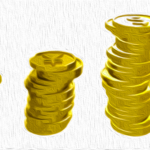
Introduction
With less than 80 days remaining until Bitcoin's fourth halving event, the excitement and speculation surrounding this milestone are reaching new heights. As we approach the scheduled date of around April 21, 2024, market expectations are fueling discussions about whether this halving will differ from its predecessors.
The Fourth Bitcoin Halving: A Countdown
Based on current statistics and Bitcoin's intended ten-minute block average, the fourth halving is anticipated to occur in approximately 78 days. However, the exact date remains uncertain due to the variable nature of block times, which can either expedite or delay the process.
For instance, the most recent block interval is currently recorded at seven minutes and 31.8 seconds, suggesting that the halving may take place as early as April 4, 2024, a mere 58 days from now. The halving event is a crucial aspect of Bitcoin's protocol, ensuring its status as a deflationary asset.
The Significance of Halving Events
Bitcoin's halving events directly impact the rate at which new bitcoins are created and the overall supply of existing bitcoins. These events occur once every 210,000 blocks, approximately every four years, given the average ten-minute block time.
The schedule for halving events was established by Bitcoin's mysterious creator, Satoshi Nakamoto. The first halving took place 1,425 days or 3.9 years after the network's launch on November 28, 2012, reducing the block reward from 50 BTC to 25 BTC.
The second halving occurred on July 9, 2016, at block height 420,000, after an interval of 1,319 days or 3.61 years. This event further reduced the block reward to 12.5 BTC.
The most recent halving, the third one, happened on May 11, 2020, at block height 630,000, following a gap of 1,402 days or 3.84 years since the second halving. It has been 1,363 days since the third halving.
Scarcity and Expectations
Following the fourth halving, Bitcoin's scarcity will increase significantly, as the inflation rate will drop from the current 1.69% annually to just 0.84% per annum. Bitcoin enthusiasts have high hopes for this event, with some analysts suggesting that BTC will become scarcer than gold and real estate.
Plan B, a pseudonymous analyst, predicts that Bitcoin's market cap will surpass that of gold, which is currently over $10 trillion, leading to a price of over $500,000 per BTC. Other strategists, such as Mando CT, also emphasize the potential for higher prices due to factors like the Federal Reserve's interest rate cuts and the approval of BTC ETFs, making it more accessible for retail investors.
Preparing for the Halving
As discussions and excitement surrounding the halving event continue to grow, it is crucial to develop a well-thought-out strategy to make the most of this significant event in the crypto cycle. Proper preparation and understanding of the potential impact can help investors navigate this milestone successfully.
Countdown and Enthusiasm
Social media platforms are abuzz with posts dedicated to the highly anticipated halving event. Enthusiasts eagerly mark off the remaining days, with some sharing charts to dismiss recent price dips in BTC. Experienced Bitcoin holders remind newcomers that corrections are a normal part of the market's volatility.
Amidst the excitement, some individuals mock those who choose to sell their BTC holdings before the halving event, highlighting the scarcity and potential price increase that may follow. With less than 11,260 blocks left until the halving occurs, the anticipation continues to build.
Conclusion
The fourth Bitcoin halving is approaching, and the anticipation surrounding this event is growing. As scarcity beckons and expectations rise, investors and enthusiasts are eagerly preparing for the potential impact on Bitcoin's price and market dynamics. With the right strategy and understanding, this halving event can be navigated successfully.
What are your thoughts on the upcoming fourth Bitcoin halving? Share your opinions and insights in the comments section below.
Frequently Asked Questions
How much of your IRA should include precious metals?
The most important thing you should know when investing in precious metals is that they are not just for wealthy people. You don't need to be rich to make an investment in precious metals. You can actually make money without spending a lot on gold or silver investments.
You might consider purchasing physical coins, such as bullion bars and rounds. It is possible to also purchase shares in companies that make precious metals. Or, you might want to take advantage of an IRA rollover program offered by your retirement plan provider.
You'll still get the benefit of precious metals no matter which country you live in. These metals are not stocks, but they can still provide long-term growth.
They also tend to appreciate over time, unlike traditional investments. So, if you decide to sell your investment down the road, you'll likely see more profit than you would with traditional investments.
How do I Withdraw from an IRA with Precious Metals?
First, you must decide if you wish to withdraw money from your IRA account. Next, ensure you have enough cash on hand to pay any penalties or fees that could be associated with withdrawing funds.
If you are willing to pay a penalty for early withdrawal, you should consider opening a taxable brokerage account instead of an IRA. If you choose this option, you'll also need to consider taxes owed on the amount withdrawn.
Next, figure out how much money will be taken out of your IRA. This calculation is affected by many factors, such as the age at which you withdraw the money, the amount of time the account has been owned, and whether your plans to continue contributing to your retirement fund.
Once you determine the percentage of your total saved money you want to convert into cash, then you need to choose which type IRA you will use. Traditional IRAs allow for you to withdraw funds without tax when you turn 59 1/2. Roth IRAs, on the other hand, charge income taxes upfront but you can access your earnings later and pay no additional taxes.
Once these calculations have been completed you will need to open an account with a brokerage. Many brokers offer signup bonuses or other promotions to encourage people to open accounts. You can save money by opening an account with a debit card instead of a credit card to avoid paying unnecessary fees.
When it's time to make withdrawals from your precious-metal IRA, you'll need a place to keep your coins safe. Some storage facilities can accept bullion bar, while others require you buy individual coins. Either way, you'll need to weigh the pros and cons of each before choosing one.
Bullion bars, for example, require less space as you're not dealing with individual coins. However, you'll need to count every coin individually. You can track their value by keeping individual coins.
Some prefer to keep their money in a vault. Others prefer to store their coins in a vault. Regardless of the method you prefer, ensure that your bullion is safe so that you can continue to enjoy its benefits for many years.
Can I hold a gold ETF in a Roth IRA?
Although a 401k plan might not provide this option, you should still consider other options like an Individual Retirement Account (IRA).
Traditional IRAs allow for contributions from both employees and employers. Another way to invest in publicly traded companies is through an Employee Stock Ownership Plan.
An ESOP gives employees tax advantages as they share the stock of the company and the profits it makes. The money in the ESOP can then be subject to lower tax rates than if the money were in the individual's hands.
A Individual Retirement Annuity (IRA), is also available. With an IRA, you make regular payments to yourself throughout your lifetime and receive income during retirement. Contributions to IRAs can be made without tax.
Can the government take your gold
Your gold is yours and the government cannot take it. You earned it through hard work. It belongs entirely to you. But, this rule is not universal. You could lose your gold if convicted of fraud against a federal government agency. Also, if you owe taxes to the IRS, you can lose your precious metals. However, if you do not pay your taxes, you can still keep your gold even though it is considered property of the United States Government.
Statistics
- Indeed, several financial advisers interviewed for this article suggest you invest 5 to 15 percent of your portfolio in gold, just in case. (aarp.org)
- You can only purchase gold bars at least 99.5% purity. (forbes.com)
- If you take distributions before hitting 59.5, you'll owe a 10% penalty on the amount withdrawn. (lendedu.com)
- If you accidentally make an improper transaction, the IRS will disallow it and count it as a withdrawal, so you would owe income tax on the item's value and, if you are younger than 59 ½, an additional 10% early withdrawal penalty. (forbes.com)
- (Basically, if your GDP grows by 2%, you need miners to dig 2% more gold out of the ground every year to keep prices steady.) (smartasset.com)
External Links
irs.gov
wsj.com
- Saddam Hussein's InvasionHelped Uncage a Bear In 90 – WSJ
- Are you interested in keeping gold in your IRA at-home? It's Not Exactly Legal – WSJ
investopedia.com
- Do You Need a Gold IRA to Get Retirement?
- What are the Options? Types, Spreads, Example, and Risk Metrics
finance.yahoo.com
How To
The best place online to buy silver and gold
Understanding how gold works is essential before you buy it. The precious metal gold is similar to platinum. It is rare and used as money due to its durability and resistance against corrosion. It's difficult to use, so most people prefer purchasing jewelry made from it rather than actual bars.
Today, there are two types available in gold coins: one is legal tender and the other is bullion. Legal tender coins are designed for circulation in a country. They often have denominations like $1 or $5 or $10.
Bullion coin are not intended for investment. However, their value will increase with inflation.
They cannot be used in currency exchanges. For example, a person who buys $100 worth or gold gets 100 grams. This gold has a $100 price. Every dollar spent on gold purchases, the buyer receives one gram of gold.
When looking to buy precious metals, the next thing you should be aware of is where it can be purchased. There are several options available if your goal is to purchase gold from a dealer. First, you can visit your local coin store. You can also go to a reputable website such as eBay. You may also be interested in buying gold through private sellers online.
Individuals selling gold at wholesale prices and retail prices are known as private sellers. Private sellers will charge you a 10% to 15% commission for every transaction. A private seller will usually return less money than a coin shop and eBay. This option is often a great choice for investing gold as it allows you more control over its price.
An alternative option to buying gold is to buy physical gold. Physical gold is much easier to store than paper certificates, but you still have to worry about storing it safely. Physical gold should be stored in an impenetrable container, such a vault and safety deposit box to ensure its safety.
When buying gold on your own, you can visit a bank or a pawnshop. A bank will provide you with a loan that allows you to purchase the amount of gold you desire. Pawnshops are small establishments allowing customers to borrow money against items they bring. Banks often charge higher interest rates then pawnshops.
A third way to buy gold? Simply ask someone else! Selling gold can also be done easily. Set up a simple account with GoldMoney.com and you will start receiving payments instantly.
—————————————————————————————————————————————————————————————–
By: Jamie Redman
Title: The Fourth Bitcoin Halving: Anticipation Grows as Scarcity Beckons
Sourced From: news.bitcoin.com/countdown-to-bitcoins-fourth-halving-a-shift-in-the-crypto-economy-looms/
Published Date: Sat, 03 Feb 2024 17:30:59 +0000
Did you miss our previous article…
https://altcoinirareview.com/nft-collections-drive-market-recovery-with-a-3-74-increase-in-weekly-sales/
















